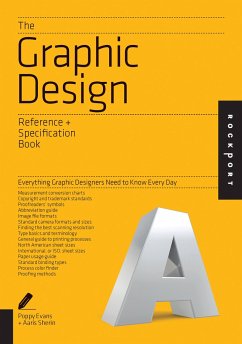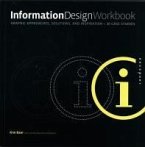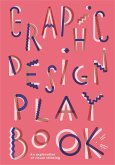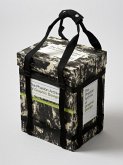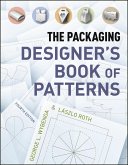Poppy Evans, Aaris Sherin, Irina Lee
The Graphic Design Reference & Specification Book
Everything Graphic Designers Need to Know Every Day
28,99 €
inkl. MwSt.
Versandfertig in über 4 Wochen

14 °P sammeln
Poppy Evans, Aaris Sherin, Irina Lee
The Graphic Design Reference & Specification Book
Everything Graphic Designers Need to Know Every Day
- Broschiertes Buch
- Merkliste
- Auf die Merkliste
- Bewerten Bewerten
- Teilen
- Produkt teilen
- Produkterinnerung
- Produkterinnerung
Completely practical with only the most needed information, this valuable book provides designers with all the little details that can make or break a design.
Andere Kunden interessierten sich auch für
![Please Make This Look Nice: The Graphic Design Process Please Make This Look Nice: The Graphic Design Process]() Peter AhlbergPlease Make This Look Nice: The Graphic Design Process28,99 €
Peter AhlbergPlease Make This Look Nice: The Graphic Design Process28,99 €![Design Elements, Color Fundamentals Design Elements, Color Fundamentals]() Aaris SherinDesign Elements, Color Fundamentals28,99 €
Aaris SherinDesign Elements, Color Fundamentals28,99 €![Information Design Workbook Information Design Workbook]() Kim BaerInformation Design Workbook22,99 €
Kim BaerInformation Design Workbook22,99 €![Graphic Design Play Book Graphic Design Play Book]() Sophie CureGraphic Design Play Book13,99 €
Sophie CureGraphic Design Play Book13,99 €![The Phaidon Archive of Graphic Design The Phaidon Archive of Graphic Design]() Nick BellThe Phaidon Archive of Graphic Design73,99 €
Nick BellThe Phaidon Archive of Graphic Design73,99 €![Minard System Minard System]() Sandra RendgenMinard System48,99 €
Sandra RendgenMinard System48,99 €![The Packaging Designer's Book of Patterns The Packaging Designer's Book of Patterns]() Laszlo RothThe Packaging Designer's Book of Patterns74,99 €
Laszlo RothThe Packaging Designer's Book of Patterns74,99 €-
-
Completely practical with only the most needed information, this valuable book provides designers with all the little details that can make or break a design.
Hinweis: Dieser Artikel kann nur an eine deutsche Lieferadresse ausgeliefert werden.
Hinweis: Dieser Artikel kann nur an eine deutsche Lieferadresse ausgeliefert werden.
Produktdetails
- Produktdetails
- Verlag: Rockport Publishers
- Seitenzahl: 230
- Erscheinungstermin: 1. September 2013
- Englisch
- Abmessung: 200mm x 141mm x 23mm
- Gewicht: 592g
- ISBN-13: 9781592538515
- ISBN-10: 1592538517
- Artikelnr.: 36400670
- Herstellerkennzeichnung
- Libri GmbH
- Europaallee 1
- 36244 Bad Hersfeld
- gpsr@libri.de
- Verlag: Rockport Publishers
- Seitenzahl: 230
- Erscheinungstermin: 1. September 2013
- Englisch
- Abmessung: 200mm x 141mm x 23mm
- Gewicht: 592g
- ISBN-13: 9781592538515
- ISBN-10: 1592538517
- Artikelnr.: 36400670
- Herstellerkennzeichnung
- Libri GmbH
- Europaallee 1
- 36244 Bad Hersfeld
- gpsr@libri.de
Poppy Evans is an award-winning writer and graphic designer who lives in Park Hills, Kentucky, a suburb of Cincinnati, Ohio. She is the former art director of Screen Printing and American Music Teacher magazines, and former managing editor of HOW magazine. Aaris Sherin is an educator, writer and designer based in New York City. She is currently assistant professor of graphic design at St. John's University in Queens, New York, where she teaches both history and studio classes. She holds a BFA from the School of the Art Institute of Chicago and an MFA from Rochester Institute of Technology. Irina Lee is a graphic designer, professor, and writer based in New York City. Her professional experience includes film and video production, interactive media, print, packaging, user interface design and editorial design projects for corporate and non-profit clients. She teaches at the School of Visual Arts and the State University of New York at Farmingdale College, School of Art + Graphic Design.
Contents
7 introduction
chapter 1:
8 measurement conversion charts
8 Millimeters, Points, and Picas to Inches
8 Inch Decimals to Inch Fractions
9 Conversion Formulas
9 Metric to Imperial Equivalents
chapter 2:
10 copyright and trademark
standards
10 Copyright
10 Public Domain
11 Transferring Rights
11 Creative Commons Licensing
12 Tradmarks and Service Marks
13 Legal Resources
chapter 3:
14 proofreading and copywriting
14 Proofreaders’ Symbols
15 Footnotes
15 Abbreviation Guide
18 Hyphenation Guide
18 Prime Marks and Quotation Marks Guide
chapter 4:
20 imaging and color
20 Image File Formatss
22 Halftone Screens
24 Tint Values for Halftone Screens
25 Duotones
26 Finding the Best Scanning Resolution
26 Scaling an Image
27 Standard Digital Image Sizes for Web
27 Standard Ad Unit Guidelines
chapter 5:
28 TYpe
28 Type Basics and Terminology
28 Categorizing Typefaces
29 Serif and Sans Serif
31 Measuring Type
33 Type Guide
34 Ways to Identify Typefaces
35 Text Typefaces
chapter 6: new
58 grid design basics
58 Types of Grids
59 Anatomy of a Grid
59 Working with Grids
64 Typographic Unit Grids
65 Composite Grids
66 Modular Grids
67 Hierarchical Grids
chapter 7:
68 paper
68 North American Sheet Sizes
69 International, or ISO, Sheet Sizes
72 Basis Weight Equivalents
73 Grammage
74 Caliper, Bulk, and PPI
75 Basis Weight/Caliper Equivalents
76 Finishes
76 Grain
78 Paper Estimator
79 Paper Usage Guide
chapter
8:
80 bindings and folds
80 Standard Binding Types
82 Which Binding Method Works Best?
83 Common Fold Styles
83 Fold Basics
85 Tolerances for Gatefolds, Barrel, or
Roll Folds
chapter 9:
86 envelopes and folders
86 Envelope Construction
87 Standard Envelope Styles and Sizes
88 Window Size and Position
91 International Envelope Sizes
92 Printing Considerations for Envelopes
93 Pocket Folder Styles
97 Printing Considerations for Pocket
Folders
chapter 10:
98 packaging styles
98 Tray-Style Cartons
101 Basic Tube-Style Cartons
102 Basic Closure Types
106 Folders, Sleeves, and Other Types
of Folding Cartons
111 Set-up Boxes
116 Common Styles of Stock Plastic
Containers
120 Paper Bags
122 Plastic Bags
chapter 11:
124 postal standards
124 General USPS Mail Classifications and
Requirements
128 Postcard Paper Stock Requirements
128 Thickness Requirements for Flat Mail
129 Rate Classifications and Delivery Time
for Domestic Mail
129 Package Standards for Mailing
131 Extra USPS Services
133 Mail Piece Design Expertise
137 Postal Websites
chapter 12:
140 bar code standards
140 General Standards for UPC Bar Codes
141 Guide to Color-Correct Bar Coding
142 Reflectance Values of Four-Color
Combinations on Uncoated Stock
145 QR Codes
145 Generating and Reading QR Codes
145 QR Content
chapter 13:
146 printing and finishing
146 General Guide to Printing Processes
149 Trapping Tolerances
150 Types of Offset Lithography
151 Cutting and Trimming
151 Finishing Techniques
154 Offset Inks
154 Varnishes and Protective Liquid
Coatings
155 Glossy versus Matte Finishes
157 Proofing Methods
chapter 14:
158 greening graphic design
158 The Shift Toward Sustainable Practice
160 Sustainable Materials and Production
for Print Design
161 Sustainable Vocabulary
164 Fiber Sourcing and Paper Production
165 Chain of Custody
166 Certifications
169 Paper Production
169 Recycled Paper
170 Paper from Mixed Sources
171 Tree-Free Paper
172 Printing
176 Guide to Environmentally FriendlyPapers
chapter 15:
178 user experience and interface design
178 User Experience (UX) Design
178 User Interface Design
chapter 16:
206 standard forms and contracts
184 Creative Briefs Are Strategic Tools
188 What’s Included in a Design Criteria
200 glossary
216 resources and recommended reading
222 process color finder
312 index
320 about the authors
7 introduction
chapter 1:
8 measurement conversion charts
8 Millimeters, Points, and Picas to Inches
8 Inch Decimals to Inch Fractions
9 Conversion Formulas
9 Metric to Imperial Equivalents
chapter 2:
10 copyright and trademark
standards
10 Copyright
10 Public Domain
11 Transferring Rights
11 Creative Commons Licensing
12 Tradmarks and Service Marks
13 Legal Resources
chapter 3:
14 proofreading and copywriting
14 Proofreaders’ Symbols
15 Footnotes
15 Abbreviation Guide
18 Hyphenation Guide
18 Prime Marks and Quotation Marks Guide
chapter 4:
20 imaging and color
20 Image File Formatss
22 Halftone Screens
24 Tint Values for Halftone Screens
25 Duotones
26 Finding the Best Scanning Resolution
26 Scaling an Image
27 Standard Digital Image Sizes for Web
27 Standard Ad Unit Guidelines
chapter 5:
28 TYpe
28 Type Basics and Terminology
28 Categorizing Typefaces
29 Serif and Sans Serif
31 Measuring Type
33 Type Guide
34 Ways to Identify Typefaces
35 Text Typefaces
chapter 6: new
58 grid design basics
58 Types of Grids
59 Anatomy of a Grid
59 Working with Grids
64 Typographic Unit Grids
65 Composite Grids
66 Modular Grids
67 Hierarchical Grids
chapter 7:
68 paper
68 North American Sheet Sizes
69 International, or ISO, Sheet Sizes
72 Basis Weight Equivalents
73 Grammage
74 Caliper, Bulk, and PPI
75 Basis Weight/Caliper Equivalents
76 Finishes
76 Grain
78 Paper Estimator
79 Paper Usage Guide
chapter
8:
80 bindings and folds
80 Standard Binding Types
82 Which Binding Method Works Best?
83 Common Fold Styles
83 Fold Basics
85 Tolerances for Gatefolds, Barrel, or
Roll Folds
chapter 9:
86 envelopes and folders
86 Envelope Construction
87 Standard Envelope Styles and Sizes
88 Window Size and Position
91 International Envelope Sizes
92 Printing Considerations for Envelopes
93 Pocket Folder Styles
97 Printing Considerations for Pocket
Folders
chapter 10:
98 packaging styles
98 Tray-Style Cartons
101 Basic Tube-Style Cartons
102 Basic Closure Types
106 Folders, Sleeves, and Other Types
of Folding Cartons
111 Set-up Boxes
116 Common Styles of Stock Plastic
Containers
120 Paper Bags
122 Plastic Bags
chapter 11:
124 postal standards
124 General USPS Mail Classifications and
Requirements
128 Postcard Paper Stock Requirements
128 Thickness Requirements for Flat Mail
129 Rate Classifications and Delivery Time
for Domestic Mail
129 Package Standards for Mailing
131 Extra USPS Services
133 Mail Piece Design Expertise
137 Postal Websites
chapter 12:
140 bar code standards
140 General Standards for UPC Bar Codes
141 Guide to Color-Correct Bar Coding
142 Reflectance Values of Four-Color
Combinations on Uncoated Stock
145 QR Codes
145 Generating and Reading QR Codes
145 QR Content
chapter 13:
146 printing and finishing
146 General Guide to Printing Processes
149 Trapping Tolerances
150 Types of Offset Lithography
151 Cutting and Trimming
151 Finishing Techniques
154 Offset Inks
154 Varnishes and Protective Liquid
Coatings
155 Glossy versus Matte Finishes
157 Proofing Methods
chapter 14:
158 greening graphic design
158 The Shift Toward Sustainable Practice
160 Sustainable Materials and Production
for Print Design
161 Sustainable Vocabulary
164 Fiber Sourcing and Paper Production
165 Chain of Custody
166 Certifications
169 Paper Production
169 Recycled Paper
170 Paper from Mixed Sources
171 Tree-Free Paper
172 Printing
176 Guide to Environmentally FriendlyPapers
chapter 15:
178 user experience and interface design
178 User Experience (UX) Design
178 User Interface Design
chapter 16:
206 standard forms and contracts
184 Creative Briefs Are Strategic Tools
188 What’s Included in a Design Criteria
200 glossary
216 resources and recommended reading
222 process color finder
312 index
320 about the authors
Contents
7 introduction
chapter 1:
8 measurement conversion charts
8 Millimeters, Points, and Picas to Inches
8 Inch Decimals to Inch Fractions
9 Conversion Formulas
9 Metric to Imperial Equivalents
chapter 2:
10 copyright and trademark
standards
10 Copyright
10 Public Domain
11 Transferring Rights
11 Creative Commons Licensing
12 Tradmarks and Service Marks
13 Legal Resources
chapter 3:
14 proofreading and copywriting
14 Proofreaders’ Symbols
15 Footnotes
15 Abbreviation Guide
18 Hyphenation Guide
18 Prime Marks and Quotation Marks Guide
chapter 4:
20 imaging and color
20 Image File Formatss
22 Halftone Screens
24 Tint Values for Halftone Screens
25 Duotones
26 Finding the Best Scanning Resolution
26 Scaling an Image
27 Standard Digital Image Sizes for Web
27 Standard Ad Unit Guidelines
chapter 5:
28 TYpe
28 Type Basics and Terminology
28 Categorizing Typefaces
29 Serif and Sans Serif
31 Measuring Type
33 Type Guide
34 Ways to Identify Typefaces
35 Text Typefaces
chapter 6: new
58 grid design basics
58 Types of Grids
59 Anatomy of a Grid
59 Working with Grids
64 Typographic Unit Grids
65 Composite Grids
66 Modular Grids
67 Hierarchical Grids
chapter 7:
68 paper
68 North American Sheet Sizes
69 International, or ISO, Sheet Sizes
72 Basis Weight Equivalents
73 Grammage
74 Caliper, Bulk, and PPI
75 Basis Weight/Caliper Equivalents
76 Finishes
76 Grain
78 Paper Estimator
79 Paper Usage Guide
chapter
8:
80 bindings and folds
80 Standard Binding Types
82 Which Binding Method Works Best?
83 Common Fold Styles
83 Fold Basics
85 Tolerances for Gatefolds, Barrel, or
Roll Folds
chapter 9:
86 envelopes and folders
86 Envelope Construction
87 Standard Envelope Styles and Sizes
88 Window Size and Position
91 International Envelope Sizes
92 Printing Considerations for Envelopes
93 Pocket Folder Styles
97 Printing Considerations for Pocket
Folders
chapter 10:
98 packaging styles
98 Tray-Style Cartons
101 Basic Tube-Style Cartons
102 Basic Closure Types
106 Folders, Sleeves, and Other Types
of Folding Cartons
111 Set-up Boxes
116 Common Styles of Stock Plastic
Containers
120 Paper Bags
122 Plastic Bags
chapter 11:
124 postal standards
124 General USPS Mail Classifications and
Requirements
128 Postcard Paper Stock Requirements
128 Thickness Requirements for Flat Mail
129 Rate Classifications and Delivery Time
for Domestic Mail
129 Package Standards for Mailing
131 Extra USPS Services
133 Mail Piece Design Expertise
137 Postal Websites
chapter 12:
140 bar code standards
140 General Standards for UPC Bar Codes
141 Guide to Color-Correct Bar Coding
142 Reflectance Values of Four-Color
Combinations on Uncoated Stock
145 QR Codes
145 Generating and Reading QR Codes
145 QR Content
chapter 13:
146 printing and finishing
146 General Guide to Printing Processes
149 Trapping Tolerances
150 Types of Offset Lithography
151 Cutting and Trimming
151 Finishing Techniques
154 Offset Inks
154 Varnishes and Protective Liquid
Coatings
155 Glossy versus Matte Finishes
157 Proofing Methods
chapter 14:
158 greening graphic design
158 The Shift Toward Sustainable Practice
160 Sustainable Materials and Production
for Print Design
161 Sustainable Vocabulary
164 Fiber Sourcing and Paper Production
165 Chain of Custody
166 Certifications
169 Paper Production
169 Recycled Paper
170 Paper from Mixed Sources
171 Tree-Free Paper
172 Printing
176 Guide to Environmentally FriendlyPapers
chapter 15:
178 user experience and interface design
178 User Experience (UX) Design
178 User Interface Design
chapter 16:
206 standard forms and contracts
184 Creative Briefs Are Strategic Tools
188 What’s Included in a Design Criteria
200 glossary
216 resources and recommended reading
222 process color finder
312 index
320 about the authors
7 introduction
chapter 1:
8 measurement conversion charts
8 Millimeters, Points, and Picas to Inches
8 Inch Decimals to Inch Fractions
9 Conversion Formulas
9 Metric to Imperial Equivalents
chapter 2:
10 copyright and trademark
standards
10 Copyright
10 Public Domain
11 Transferring Rights
11 Creative Commons Licensing
12 Tradmarks and Service Marks
13 Legal Resources
chapter 3:
14 proofreading and copywriting
14 Proofreaders’ Symbols
15 Footnotes
15 Abbreviation Guide
18 Hyphenation Guide
18 Prime Marks and Quotation Marks Guide
chapter 4:
20 imaging and color
20 Image File Formatss
22 Halftone Screens
24 Tint Values for Halftone Screens
25 Duotones
26 Finding the Best Scanning Resolution
26 Scaling an Image
27 Standard Digital Image Sizes for Web
27 Standard Ad Unit Guidelines
chapter 5:
28 TYpe
28 Type Basics and Terminology
28 Categorizing Typefaces
29 Serif and Sans Serif
31 Measuring Type
33 Type Guide
34 Ways to Identify Typefaces
35 Text Typefaces
chapter 6: new
58 grid design basics
58 Types of Grids
59 Anatomy of a Grid
59 Working with Grids
64 Typographic Unit Grids
65 Composite Grids
66 Modular Grids
67 Hierarchical Grids
chapter 7:
68 paper
68 North American Sheet Sizes
69 International, or ISO, Sheet Sizes
72 Basis Weight Equivalents
73 Grammage
74 Caliper, Bulk, and PPI
75 Basis Weight/Caliper Equivalents
76 Finishes
76 Grain
78 Paper Estimator
79 Paper Usage Guide
chapter
8:
80 bindings and folds
80 Standard Binding Types
82 Which Binding Method Works Best?
83 Common Fold Styles
83 Fold Basics
85 Tolerances for Gatefolds, Barrel, or
Roll Folds
chapter 9:
86 envelopes and folders
86 Envelope Construction
87 Standard Envelope Styles and Sizes
88 Window Size and Position
91 International Envelope Sizes
92 Printing Considerations for Envelopes
93 Pocket Folder Styles
97 Printing Considerations for Pocket
Folders
chapter 10:
98 packaging styles
98 Tray-Style Cartons
101 Basic Tube-Style Cartons
102 Basic Closure Types
106 Folders, Sleeves, and Other Types
of Folding Cartons
111 Set-up Boxes
116 Common Styles of Stock Plastic
Containers
120 Paper Bags
122 Plastic Bags
chapter 11:
124 postal standards
124 General USPS Mail Classifications and
Requirements
128 Postcard Paper Stock Requirements
128 Thickness Requirements for Flat Mail
129 Rate Classifications and Delivery Time
for Domestic Mail
129 Package Standards for Mailing
131 Extra USPS Services
133 Mail Piece Design Expertise
137 Postal Websites
chapter 12:
140 bar code standards
140 General Standards for UPC Bar Codes
141 Guide to Color-Correct Bar Coding
142 Reflectance Values of Four-Color
Combinations on Uncoated Stock
145 QR Codes
145 Generating and Reading QR Codes
145 QR Content
chapter 13:
146 printing and finishing
146 General Guide to Printing Processes
149 Trapping Tolerances
150 Types of Offset Lithography
151 Cutting and Trimming
151 Finishing Techniques
154 Offset Inks
154 Varnishes and Protective Liquid
Coatings
155 Glossy versus Matte Finishes
157 Proofing Methods
chapter 14:
158 greening graphic design
158 The Shift Toward Sustainable Practice
160 Sustainable Materials and Production
for Print Design
161 Sustainable Vocabulary
164 Fiber Sourcing and Paper Production
165 Chain of Custody
166 Certifications
169 Paper Production
169 Recycled Paper
170 Paper from Mixed Sources
171 Tree-Free Paper
172 Printing
176 Guide to Environmentally FriendlyPapers
chapter 15:
178 user experience and interface design
178 User Experience (UX) Design
178 User Interface Design
chapter 16:
206 standard forms and contracts
184 Creative Briefs Are Strategic Tools
188 What’s Included in a Design Criteria
200 glossary
216 resources and recommended reading
222 process color finder
312 index
320 about the authors
